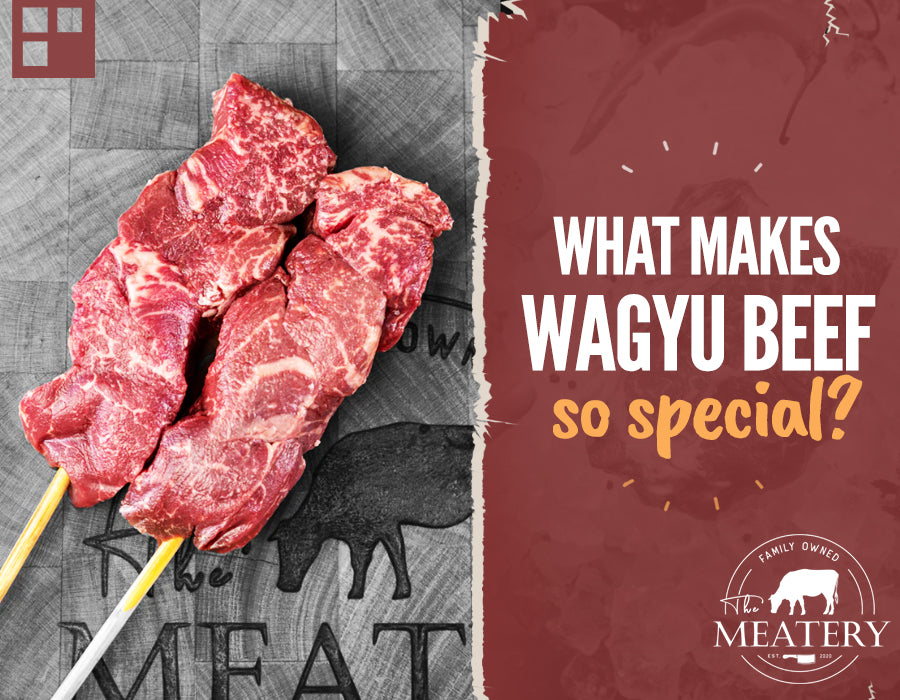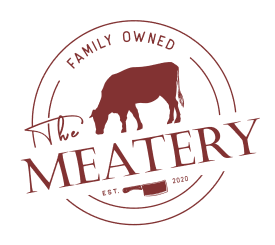If you’ve been curious to learn more about various types of beef, you have likely come across Wagyu. For decades, Wagyu beef has been regarded as one of the most prized and sought-after meats in the world. Although originally from Japan, Wagyu beef has expanded into a global sensation and is consumed by enthusiasts around the world.
Here, we explain what makes Wagyu beef so special in the eyes of chefs, food connoisseurs, and steak enthusiasts around the world.
What is Wagyu Beef?
If you’re wondering what makes a steak Wagyu, you’re not alone. Wagyu can be translated into “Japanese cow” (wa = Japanese, gyu = cow) and can be found in four different types of Japanese cattle: Aakage (Brown), Kuroge (Black), Mukaku (Polled), and Nihon Tankaku (Shorthorn).
Wagyu beef is highly revered for its vast fat deposits, commonly referred to as marbling. When examining Wagyu beef, it will appear rich in large fatty streaks throughout every cut. For beef to qualify as Wagyu, it must be graded as such. In Japan, this is done by the Japanese Meat Grading Association.
What Makes Wagyu Beef So Special?
So what makes Wagyu beef different than a common steak found in your local grocery store? Wagyu beef typically outshines all other forms of beef thanks to its rich, tender, and unparalleled taste. The abundance of fat (or marbling) found in Wagyu directly contributes to these aforementioned characteristics.
To achieve remarkable levels of fat (or marbling), Wagyu beef cattle are raised in a far different manner than common cattle found roaming the American landscape. Wagyu cows are raised by experienced farmers that provide the cattle with specific diets. In some cases, Wagyu cattle can often sell for as much as $30,000 at auction. Wagyu farmers also take great care to ensure that their cattle are not exposed to great deals of stress, since tense muscles can contribute to lower quality beef.
Another reason why Wagyu beef is so special is due to its highly regulated grading and production, particularly in Japan. Some Japanese Wagyu cattle may also undergo genetic testing in order to see if they are worthy to take part in the reproductive cycle. Wagyu cattle’s specific diets and strict production guidelines all contribute to the amazing taste and higher-than-average cost associated with the beef.
Regional Differences in Wagyu Beef
Wagyu beef is renowned for its exceptional quality and rich flavor, but not all Wagyu is created equal. The term "Wagyu" encompasses various types of beef from different regions, each with its own unique characteristics and qualities. Understanding these regional differences can help you appreciate the diverse profiles of Wagyu beef and select the best cut for your preferences.
Japanese Wagyu: The Gold Standard
Japanese Wagyu is often considered the epitome of high-quality beef. It includes several prestigious breeds, such as Kobe, Matsusaka, and Ohmi, each with its distinct traits:
-
Kobe Beef: Originating from the Hyogo Prefecture, Kobe beef is perhaps the most famous type of Wagyu. It is renowned for its intense marbling, tenderness, and rich flavor. Kobe beef must come from the Tajima strain of Kuroge cattle and adhere to strict standards, including being born, raised, and slaughtered in Hyogo Prefecture.
-
Matsusaka Beef: Hailing from the Mie Prefecture, Matsusaka beef is known for its deep marbling and buttery texture. It is often described as having a sweeter taste compared to other Wagyu varieties. Like Kobe, Matsusaka beef must meet rigorous quality standards and is highly sought after for its superior eating experience.
-
Ohmi Beef: Produced in Shiga Prefecture, Ohmi beef is one of Japan’s oldest and most esteemed beef varieties. It is celebrated for its smooth, tender texture and mild, umami-rich flavor. Ohmi beef is known for its fine marbling and exceptional quality, making it a favorite among connoisseurs.
American Wagyu: A Growing Contender
American Wagyu, a crossbreed of Japanese Wagyu and American cattle, offers a unique twist on traditional Wagyu. The blend of Japanese genetics with American ranching practices results in a beef that maintains the rich marbling of Wagyu while incorporating characteristics of American beef:
-
American Wagyu Ribeye: This cut often features a robust flavor and a significant amount of marbling. The American version tends to be slightly less tender than its Japanese counterparts but offers a great balance of richness and beefiness, making it a popular choice for steak lovers.
-
American Wagyu New York Strip: Known for its flavorful and well-marbled texture, American Wagyu New York Strip offers a juicy, satisfying bite. It’s a versatile cut that performs well whether grilled, seared, or broiled.
-
American Wagyu Brisket: Although not as commonly found as other cuts, American Wagyu brisket provides a rich and flavorful option for slow-cooking enthusiasts. The marbling in this cut adds depth and tenderness, ideal for smoked or braised dishes.
Australian Wagyu: A Unique Perspective
Australian Wagyu, produced mainly in Queensland and New South Wales, offers its own distinct profile while adhering to the Wagyu breeding principles:
-
Australian Wagyu Ribeye: This cut is noted for its high marbling and tender texture, similar to Japanese Wagyu but with a slightly different flavor profile due to the Australian grazing practices. Australian Wagyu often has a more pronounced beefy flavor compared to its Japanese counterparts.
-
Australian Wagyu Striploin: Offering a balance of marbling and texture, the Australian Wagyu Striploin is well-regarded for its juiciness and rich flavor. It’s an excellent choice for grilling or pan-searing.
-
Australian Wagyu Filet Mignon: This cut combines the tenderness of Wagyu with a refined, buttery texture. It’s ideal for those seeking a melt-in-your-mouth experience with a touch of Australian flavor.
What Do They Feed Wagyu Beef?
One of the most important factors that make Wagyu beef so special is the strict diet they are fed since birth. To ensure a rich and tender cut of beef, Japanese Wagyu cattle are typically given a diet that aims to maximize their marbling.
Japanese Wagyu cattle are often given a high-energy diet largely composed of grains. The various combinations of feed are carefully controlled and adjusted to account for the age and condition of the cow. Contrary to many popular myths, Wagyu cattle are typically not fed human-like food or drinks.
Common Misconceptions About Wagyu Beef
Wagyu beef is often celebrated for its exceptional quality, but with its high profile comes a variety of misconceptions. These myths can lead to misunderstandings about what Wagyu is, how it’s produced, and why it’s so expensive. Let’s debunk some of the most common misconceptions about Wagyu beef.
1. All Wagyu Beef Is the Same
Misconception: Many people believe that all Wagyu beef is identical, regardless of its source or grading.
Reality: Wagyu beef varies significantly depending on its origin, breed, and grading. Japanese Wagyu, such as Kobe or Matsusaka, is known for its exceptional marbling and texture, often surpassing other types of Wagyu. American and Australian Wagyu, while still high-quality, can have different flavor profiles and marbling due to differences in breeding and feeding practices. Understanding these differences helps in selecting the right Wagyu for your taste preferences.
2. Wagyu Cattle Are Fed Human Food
Misconception: There is a belief that Wagyu cattle are fed luxury items like beer or sake to enhance their flavor.
Reality: While Wagyu cattle are indeed given a special diet to maximize marbling, they are not fed human food or alcoholic beverages. Instead, their diet typically consists of high-energy grains and carefully balanced nutrients designed to promote intramuscular fat development. The notion that they drink beer or sake is a myth, although some farmers might use beer as an appetite stimulant, it is not a regular practice.
3. Wagyu Beef Is Unhealthy Due to Its Fat Content
Misconception: Some assume that Wagyu beef’s high marbling makes it unhealthy compared to other types of beef.
Reality: Wagyu beef does have a higher fat content, but it contains a higher proportion of monounsaturated fats and omega-3 and omega-6 fatty acids compared to conventional beef. These types of fats are considered healthier and can have benefits such as improved heart health. Additionally, the marbling in Wagyu contributes to its tender texture and rich flavor, which many consider worth the indulgence.
4. All Wagyu Beef Is Overpriced
Misconception: There’s a notion that all Wagyu beef is overpriced and not worth the cost.
Reality: While it’s true that high-quality Wagyu beef can be expensive, this price reflects the meticulous care, breeding, and feeding practices involved in its production. The cost also accounts for the premium marbling and flavor that Wagyu offers. However, not all Wagyu is prohibitively expensive. There are various grades and cuts available at different price points, allowing you to enjoy Wagyu beef without breaking the bank.
5. You Can Only Get Authentic Wagyu from Japan
Misconception: Many believe that authentic Wagyu beef can only come from Japan.
Reality: While Japan is renowned for its Wagyu, high-quality Wagyu is also produced in other countries, including the United States and Australia. These regions have adopted Japanese breeding techniques and adapted them to local conditions, producing Wagyu beef that meets high standards of quality. It’s important to look for reputable sources such as The Meatery and understand the grading systems to ensure you’re getting genuine Wagyu.
6. Wagyu Beef Is Always Served Well-Done
Misconception: Some think that Wagyu beef is best cooked well-done to make it tender and flavorful.
Reality: Wagyu beef is best enjoyed when cooked to medium-rare or medium to preserve its delicate marbling and tender texture. Cooking Wagyu well-done can cause it to lose its unique qualities and become less enjoyable. Properly cooking Wagyu allows you to experience its rich flavor and buttery texture as intended.
7. All Wagyu Beef Is the Same Quality
Misconception: There’s a belief that all Wagyu beef, regardless of grade, has the same quality and flavor.
Reality: Wagyu beef is graded based on its marbling, color, and fat quality. Higher grades like A5 or BMS 12 offer superior marbling and tenderness compared to lower grades. Understanding these grades helps you select the right cut for your needs and ensures you get the best possible Wagyu experience.
By clarifying these misconceptions, you can better appreciate the true value of Wagyu beef and make more informed choices when selecting and enjoying this premium meat.
Final Note
Wagyu beef is revered around the world for its buttery taste and fine marbling. In order to find the highest quality Wagyu available, you’ll need to work with a trusted butcher that knows and understands the ins and outs of Wagyu. The Meatery is dedicated to supplying our customers with only the highest grades of American, Australian, and Japanese Wagyu. To view our hand-selected cuts, or to learn more about our diverse offerings, visit us online or in-person at our San Diego butchery.









